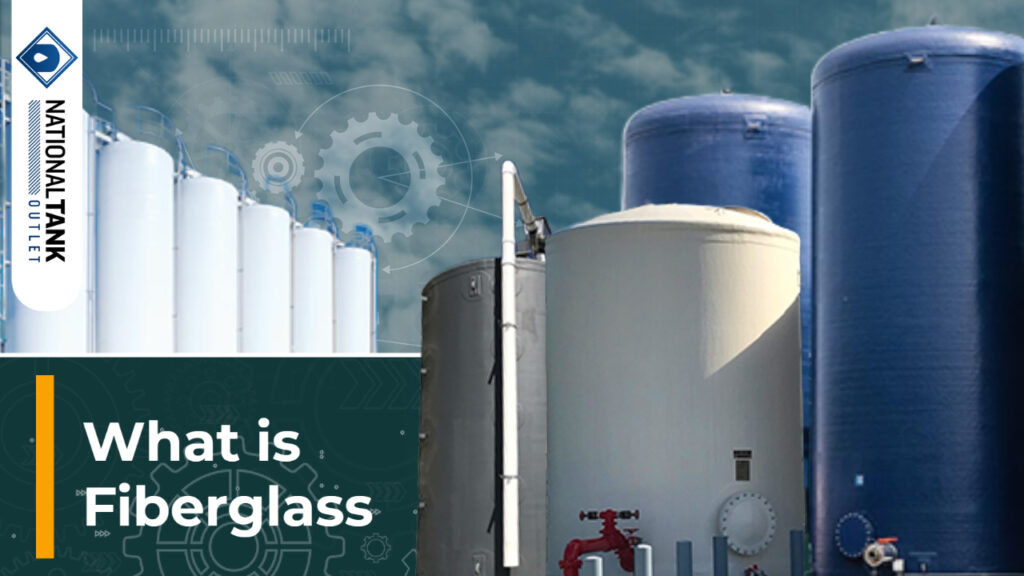
The term fiberglass originates from a trade name started by an initial manufacturer and that has become commonly used to describe the structural material known as glass fiber reinforced plastic. Glass fiber reinforced plastic, also called fiber reinforced polymer (FRP) or glass reinforced plastic (GRP), is a synthetic-composite type material, where synthetic means man-made and composite means made of more than one component.
Fiberglass Build and Characteristics
Fiberglass composites use fibrous strands of glass to effectively reinforce and contribute desirable characteristics to a polymer (i.e. plastic) base matrix. Due to the use of polymer resins in FRP equipment fabrication, resulting products can be constructed and/or molded into various shapes and sizes.
Four main types of ingredients are often used in the production of fiberglass and fiberglass items: the base polymer plastic resin, the reinforcing strand material, a lining, and additives such as colorants and UV protective compounds. Silica-based glass is commonly the reinforcing strand material used in FRP products, such as fiberglass water tanks, but carbon is another material sometimes used.
Fiberglass products are known and often selected for certain beneficial characteristics. In general, fiberglass offers stability, durability, reduction in noise, reduced heat and electrical conductivity, fire and smoke retardancy, corrosion resistance, abrasion resistance, and a long service life.
How is Fiberglass Used
Fiberglass materials are frequently used in structural engineering, construction and product fabrication within industrial, commercial and consumer based scenarios. Sector applications include agriculture, food and beverage industries, chemical synthesis, aerospace, paper and pulp, mining, petrochemical and energy production.
Resulting fiberglass products are lightweight compared to metals, and they are more resilient to temperatures, environmental stress cracking, weight and pressure strains than plastics alone. Common examples that use fiberglass include marine vessels, aircraft, storage tanks, underground tanks and holding tanks, pipes and plumbing used for chemicals, hot and cold water storage, potable water handling, wastewater and desalination facilities, as well as various commonplace items such as baths, hot tubs, swimming pools, automobiles and sports equipment.
Fiberglass Properties and Build Types
Fiberglass as a composite material can be significantly durable against both physical and chemical strains. The extent of FRP’s compatibility is dependent on the polymer resin, the reinforcing fiber type used in production and how it is arranged within the polymer matrix. The polymer used as well as the method and specific type of fiber integrated can vary significantly based on the needs of the final FRP product and an application’s requirements.
Manufacturers and engineers of fiberglass equipment will consider various factors of chemical fluid or gaseous exposure, weight stress loads and environmental concerns when determining the ideal polymer matrix and integrated fiber design type. The FRP production polymers selected are often thermoset plastics such as epoxy, vinyl ester and polyester but thermoplastic materials such as polyethylene and polypropylene are also used. Examples of fiber integration design types include random arrangement, chopped strand, filament winding, hand lay-up, ortho lay-up, and fabric weave. Due to the various methods available for FRP item fabrication, the resulting equipment, tanks, pipes, etc. can be of very large sizes and unique shapes.
The reinforcing fiber used in most fiberglass products is glass, which too is refined and intentionally selected according to specific properties and resistance standards. The glass strands incorporated to reinforce the polymer base are frequently low defect, low impurity glasses. FRP products can be classified as A-glass (alkali glass), C-glass (chemical glass), E-glass (electrical glass) and S-glass (structural glass) where each type is ideal and specifically chosen for certain applications.
Within chemical applications, C-glass FRP products are frequently selected as an effectively resistant option. When, however, the material still expresses chemical sensitivity, FRP equipment can have corrosion veils installed. FRP corrosion veils are an additional internal layer of an inert plastic material with known chemical resistance, often polyethylene or polypropylene. The full resulting details of the FRP product in terms of resin selection, composition of the glass fibers, how the strands were integrated, as well as any fillers and additives define the resulting parameters, classification and acceptable use of the final FRP product.
Fiberglass for Water Storage
Fiberglass has a decent history of use in water storage and handling applications. Often used in agricultural settings, municipal water treatment plants, food processing companies, and the oil and gas industry, fiberglass water tanks provide a long-term solution to bulk water needs. They are often chosen as they are resistant to corrosion from water and weathering, have low to no maintenance requirements, and can be kept indoors, outdoors, or installed underground. Fiberglass water tanks are often used to keep large volumes of water on-hand for production lines, fire suppression, and potable water supply, and are sometimes used in private water sourcing such as rainwater harvesting.
Fiberglass tanks used for water storage are engineered and manufactured in accordance with federal and national standards and health and safety guidelines. Manufacturing standards include ASTM D3299, ASTM 4097, AWWA, and ANSI/NSF 61.
Takeaway | What is Fiberglass
Fiberglass is a synthetic, composite material used in the manufacture of various modern products, including storage and handling tanks. As a material, fiberglass provides a long service life, superior corrosion resistance and weatherability. Due to the composite nature, fiberglass products can be made with different individual materials and manufactured using different techniques to yield final products with different end characteristics, properties, and application compatibility.
As America’s liquid tank superstore, we partner with today’s top manufacturers to specialize in providing one of the best selections in storage and handling containers, including fiberglass water tanks. You can find our selection of storage tanks here. We also specialize in custom tanks built to match the needs of unique applications. For any product inquiries, custom quotes, or assistance, contact us, our support experts are always ready to help.